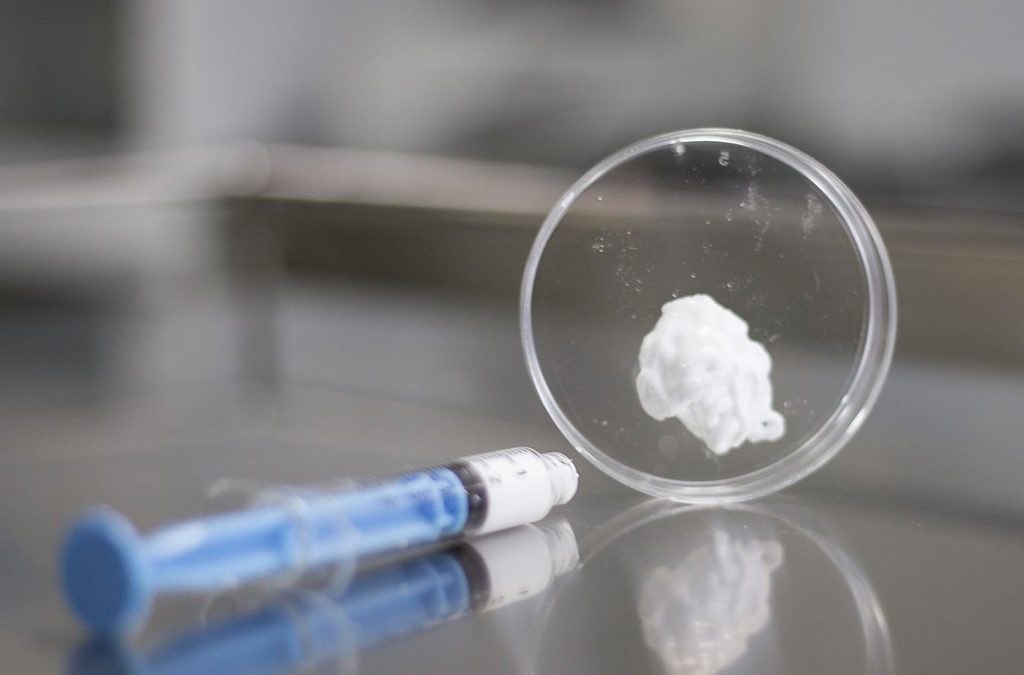Synthetic Bone Grafts

Periodontitis, β-TCP, Putty By Powerbone
June 6, 2021
Chabahar Port
August 26, 2021Fabrication and Characterization of Silicate Additive Synthetic Bone Grafts in Defined Geometries.
In the field of bone tissue engineering, there has still been a great amount of demand on synthetic bone graft that induces differentiation of osteoprogenitor cells by cell-matrix interaction at the nanoscale as well as mimicking micro-assembly of compact bone while providing high mechanical strength. Within the scope of this study, we aimed to develop Synthetic Silicate additive osteoinductive block bone grafts based on beta-tricalcium phosphate in the form of stick, block, and cylinder with tunable porosity, radiopaque and mechanical properties.
The aim of this study was to develop and characterize silicate additive osteoinductive block grafts with tunable porosity, radiopacity and mechanical properties for bone regeneration applications.
MATERIALS AND METHODS
The β-TCP synthesis was carried out by a chemical precipitation method according to developed methodology by Bonegraft Co.
Polyvinyl alcohol solution (10% w/v) was used as a ceramic binding agent while Polyethylene was used as a pore-forming agent which has 50% w/v concentration for the production of block graft. Firstly, the specified amounts of β-TCP and polyethylene powders were mixed in solid form. Then 10 % PVA solution was added to the mixture at 50 % (w/v). The added materials were mixed using a special mixer until they became homogeneous ceramic dough. The prepared ceramic doughs were placed into Teflon molds and pressed with the manual press and the ceramic molecules were contacted with each other. The doughs extracted from the molds were dried in the oven at 60 _ for 3 hours. For the sintering of dried blocks, indicated steps in Figure 1 were used.
Silicate Additive Synthetic Block Grafts were produced with an inorganic non-metallic material as a radiopaque agent which do not leave at risk the graft materials at any biocompatibility point, respectively in order to enhance antibacterial efficacy and determine a radiopaque characteristic of the developed bone grafts. The produced prototypes were performed lyophilizing for 24 hours at -55 using a freeze-drying machine after then characterized by µ-CT analysis as is seen in Figure 2.
Uniaxial compression tests were performed with Shimadzu AG-IS10kN (Shimadzu Corp., Kyoto, Japan) test machine with parallel face samples to determine the mechanical strength. Tests were performed at room conditions perpendicular to the pressing surface with a jaw speed of 1 mm/min. The test was repeated in 6 samples to ensure the consistency of the mechanical values. When the standard deviations are taken into consideration, the test samples which are outside of the maximum and minimum values are neglected.
In accordance with ISO 10993 standard, the implantation test was performed at the Hüseyin Aytemiz Experimental Research and Execution Laboratory affiliated to the Scientific and Technological Researches Laboratories Directorate by taken service procurement, and Krkkale University Animal Experiments Local Ethics Committee Decision was taken on 25.09.2014 (Decision Number: 14/77). The rabbits were anesthetized by injecting Nembutal into an ear vein, about 40 mg/kg body weight. The operative sites were shaved and disinfected with iodine. The muscle pedicle was dissected to a length of 1 cm and graft was fixed, so as to be in touch with the cut-off muscle.
RESULTS AND DISCUSSION
As a result of the μ-CT analysis, it was reported that the produced block grafts had a porosity of approximately 52% and the mean pore diameter was 63.5 μm (SD ± 2.7). Figure 2 clearly shows that the pores between 5-200 μm are homogeneous as a result of three-dimensional (3D) analysis.
When the SEM images in Figure 3 were examined, it is seen that the sample has a porous structure and this structure spread throughout the sample which is also supported by μ-CT analysis. Also, from the images, besides the larger pore structures, the presence of smaller and relatively smaller pore structures with interconnection is clearly seen. Considering cell adhesion and development, it has been clearly stated in the literature studies that the porosity of the structure and the presence of pores in contact with each other increase cell adhesion and development.
The data obtained as a result of the compression test of the produced block grafts are shown in Table 1. When the data in Table 1 is examined, the average strength and modulus values of the porous block grafts are consistent with the data obtained in the literature studies. As can be seen from the literature, the compressive strength value of natural cancellous bone is around 1.9 MPa. It is seen that the strength value of the analyzed product (3.08 ± 0.15 MPa) is above this value and it can meet the properties of natural cancellous bone in terms of mechanical properties as well as its porous structure.
Osteoid formation can be seen in Figure 6 which proves the osteoinductive characteristics of. It was speculated that resorbed β-TCP grafts released calcium and phosphate ions into the surrounding tissue which enhances osteogenic differentiation of neighborhood mesenchymal stem cell and induce formation of osteoids.
CONCLUSION
As shown in Figure 7, Silicate additive block grafts of different geometric shapes and sizes like a stick, block and cylinder have been successfully produced by Bonegraft Co. and CE certification processes have been completed. The results of the study confirm that silicate additive synthetic osteoinductive block grafts based on β-TCP with tunable porosity, radiopacity and mechanical properties for bone regeneration applications were successfully manufactured.



1 Comment
great